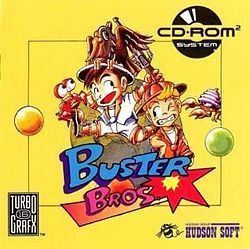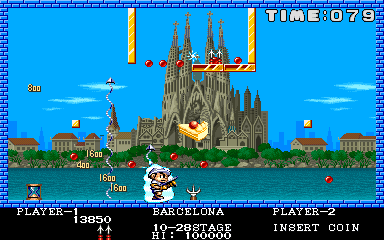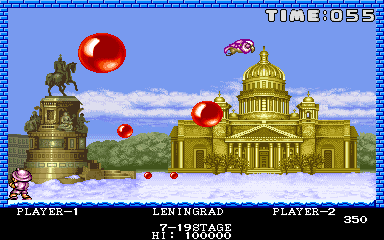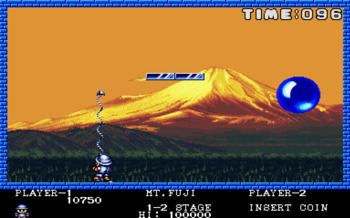Director(s) Yoshiki Okamoto Genre(s) Arcade Initial release date 1989 Mode Multiplayer video game | Composer(s) Tamayo Kawamoto Cabinet Upright Designer Yoshiki Okamoto | |
 | ||
Display Raster, standard resolution Platforms Arcade game, PlayStation Developers Capcom, Mitchell Corporation Publishers Capcom, Mitchell Corporation, Hudson Soft, Ocean Software, The Hit Squad Similar Capcom games, Puzzle video games | ||
Pang (パン, Pan), also known as Pomping World (Japanese: ポンピング・ワールド, Hepburn: Ponpingu Wārudo), is a cooperative two-player arcade video game released in 1989 by the Mitchell Corporation. The North American release from Capcom was entitled Buster Bros..
Contents

In the game, the Buster brothers must finish a round-the-world quest to destroy bouncing balloons that are terrorizing several of Earth's landmarks and cities. The fight to save the Earth begins on Mt. Fuji, Japan, where the brothers must pass all three stages before moving on to the next location. The basic gameplay is identical to a much earlier 1983 Japanese computer game called Cannon Ball (also released in 1983 on the ZX Spectrum as Bubble Buster). Cannon Ball was made by Japanese publishers Hudson Soft, and possibly inspired Mitchell Corp. to make Buster Bros. six years later.

Conversions for home systems were produced by Ocean Software in 1990 for the ZX Spectrum, Commodore 64, Amstrad CPC, Commodore Amiga, MS-DOS and Atari ST.

Game scenario

There are 50 stages at 17 locations: Mt. Fuji, Mt. Keirin, the Temple of the Emerald Buddha, Angkor Wat, Ayers Rock, the Taj Mahal, Leningrad, Paris, London, Barcelona, Athens, Egypt, Kenya, New York, Maya ruins, Antarctica, and finally Easter Island.
Each location has a unique background that shows the area's most famous landmarks. The stages contain a different layout of blocks, some that disappear after being shot, others that do not, and still others that are hidden and can reveal bonuses.
The stages start with differing numbers and sizes of balloons. The largest balloon divides for the first three times it is popped; after the fourth and smallest balloon is popped it vanishes. Each player starts with a single harpoon. When a balloon is popped, special weapons may drop down.
The other weapons include:
There is no ammunition limit to any weapon. The names of the weapons differ between the monitor bezel (given above) and the game's attract mode. Other bonuses include:
At a certain point in the stage, a food item will drop down that is worth several hundred (or thousand in the later stages) bonus points. These are different and of increasing value, until a 48,000-point cake slice is reached; thereafter the bonuses are all cake slices, alternating between 48,000 and 50,000 points.
If a player touches a balloon of any size, the player dies and both players must start the stage again.
When both players touch a balloon at the same time, only Player 1 will lose a life but this is somewhat offset because when both players reach a bonus or weapon simultaneously only Player 1 will get it.
Players start with 3-5 lives depending on the dip switch setting. Extra lives are also given when certain point totals have been accumulated. The stage ends when all of the balloons are successfully cleared. The game ends after all stages have been completed and our heroic duo ride their jeep into the sunset on an Easter Island beach.
In some later versions, there are more than 17 locations.
Reception
The original, and the conversions, were all critically acclaimed, although minor complaints were made about the ZX Spectrum's multi-load system. The Commodore 64 and Amstrad CPC+/GX4000 conversion was available on cartridge only.
The ZX Spectrum version was awarded 94% in the February 1991 issue of Your Sinclair and was placed at number 74 in the "Your Sinclair official top 100". Amiga Power were even more enthusiastic, listing it as the 11th best game ever in their initial Top 100 list, published with Amiga Format in April 1991 as a preview of the magazine.
Sequels
This game has several sequels:
Compilation
The first three versions of the game were released as a compilation on the PlayStation under the name of Super Pang Collection (Buster Bros. Collection in North America) in 1997. Buster Bros and Super Buster Bros were also included in the PSP game Capcom Puzzle World in 2007.
